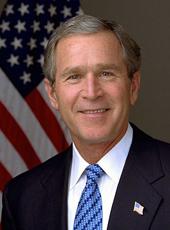Today's Presidential Action
- Today, President Bush visited Florida Community College at Jacksonville to announce expansion of the Pell Grant program through reforms to the student loan program. The expansion will provide more assistance for low-income students to receive higher education and enter the workforce with skills necessary to succeed.
- The President's Fiscal Year 2006 budget will increase the maximum Pell Grant award to $4,150 this year and $4,550 over five years to help more students in need pay for higher education and prepare for a lifetime of achievement. The President's budget request will increase investments in Pell Grants by more than $15 billion over the next 10 years to provide extra assistance for the Nation's low-income Pell Grant recipients.
- Today, the President also highlighted his plan to ensure every adult can access the skills and knowledge needed to succeed in the workplace. President Bush believes we must close the skills gap so we fill every job with a well-trained American worker.
Background on Today's Presidential Action
Many low- and middle-income students across America rely upon both Pell Grants and student loans to afford a quality, postsecondary education. Although the President's budgets continue to provide significant levels of student aid, more funding is needed for Pell Grants to make college more affordable for the neediest students. In addition, the current student loan programs do not make loans available to students in a cost effective manner, and a disproportionate amount of benefits are provided to borrowers out of school rather than those currently attending school. The current Federal student aid system does not serve American students well, and is not the best way to use taxpayer money.
Helping More Students with Increased Pell Grants
- To make student loan programs more cost-effective, President Bush will reform the programs by reducing excessive subsidies and program costs, while providing additional benefits to students in school.
- By using taxpayer money wisely, the President's new reforms will create savings over 10 years to provide $4.3 billion to eliminate the current Pell Grant shortfall; $15.0 billion to increase the Pell Grant maximum award by $100 a year for the next five years (from FY06 through FY10), which will increase the maximum award for low-income students to $4,550; and make permanent the expanded loan forgiveness for math, science, and special education teachers passed last year. An estimated 5.5 million students will receive a Pell Grant, an increase of more than one million since 2001.
The President's Current Initiatives to Improve Higher Education and Job Training
Eighty percent of the fastest-growing jobs of the 21st century require post-secondary education or training. The President's higher education and job training proposals make the system more user-friendly – more oriented to the needs of today's students – and ensure students have access to programs that will provide the skills needed in the globally competitive 21st century economy.
- Enhanced Pell Grants. The President will propose establishing a $33 million program to enhance Pell Grants to reward low-income students who participate in the State Scholars Program by taking a rigorous high school curriculum. This program would provide up to an additional $1,000 per year for the first two years of college for approximately 36,000 low-income graduating high school seniors who would be eligible next year to receive an enhanced Pell Grant under this proposal.
- Year-Round Pell Grants for Low-income Students. The President's proposals will permit the availability of year-round Pell Grants for students who are accelerating their program of study with the intent of graduating early. Currently, students are allowed to receive only one Pell Grant during a single award year, which discourages students from attending school throughout the entire school year so they can graduate earlier, including completing a four-year program in three years.
- Community College Access Grants. The President's FY 2006 budget will provide $125 million to promote dual-enrollment programs, which allow high school students to earn college credit, and to encourage states to create policies to make it easier for students to transfer credits earned at community colleges to four-year institutions.
- Increased Flexibility of Student Aid Programs and New Loans for Short-Term Training. The President's plan will increase post-secondary education options and eliminate needless student aid restrictions – particularly for adult students – giving them greater access to the skills they need to succeed. And, to make worker training more affordable, the President will propose to make loans available to help workers pay for short-term training.
- Presidential Math and Science Scholars Fund. To ensure that America's graduates have the training they need to compete for the best jobs of the 21st century, President Bush will propose establishing a new public-private partnership to provide $100 million in grants to Pell-eligible, low-income students who study math or science. Under this plan, approximately 20,000 low-income students would receive up to $5,000 each to study math or science.
- Double the Number of Workers Receiving Job Training. President Bush will propose to reform the Workforce Investment Act to ensure that job training programs work better for America's workers. The workforce training reforms will reduce overhead, red tape, and duplication, and give states more flexibility while requiring stronger accountability and clear results. The President's reforms will also give workers more choices about their job training by increasing the use of personal job training accounts called Innovation Training Accounts (ITAs).
- Community-Based Job Training Grants. To help America's community colleges train 100,000 additional workers for the industries that are creating the most new jobs, the President will again propose $250 million to continue the Community-Based Job Training Grants. These grants will help community colleges produce graduates with the skills most in demand by local employers.
George W. Bush, Fact Sheet: Strengthening Higher Education for a Successful Workforce Online by Gerhard Peters and John T. Woolley, The American Presidency Project https://www.presidency.ucsb.edu/node/282092

